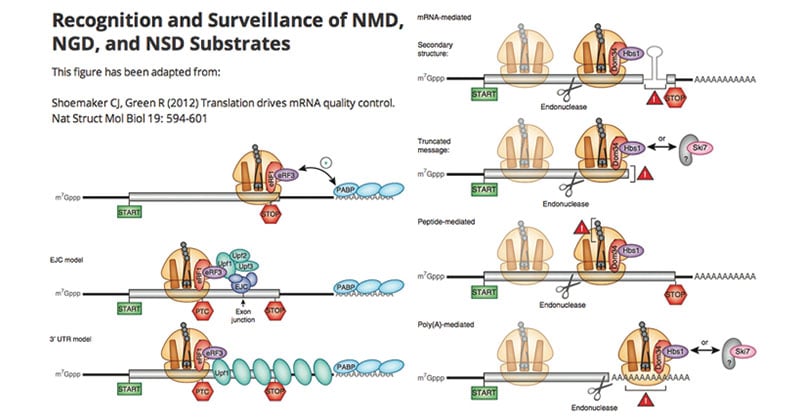Translational regulation refers to the control of the levels of protein synthesized from its mRNA.
In eukaryotes, regulation of protein synthesis can occur by modification of DNA or at the level of transcription within the nucleus, processing of mRNA in the nucleus, or translation in the cytoplasm.
Interesting Science Videos
A. Regulation through Changes in Genes
- Genes can be lost (or partially lost) from cells so that functional proteins can no longer be produced (e.g., during differentiation of red blood cells).
- Genes can be amplified. For example, the drug methotrexate causes hundreds of copies of the gene for the enzyme dihydrofolate reductase to be produced, which results in resistance to the drug.
- Segments of DNA can move from one location to another on the genome, associating with each other in various ways so that different proteins are produced. Example: A number of different potential sequences (or arrangements) occur for various portions of an antibody-producing gene.
- Modification of the bases in DNA affects the transcriptional activity of a gene.
- Cytosine can be methylated at its 5 position, which often occurs in CpG islands within promoter regions.
- The greater the extent of methylation, the less readily a gene is transcribed.

B. Regulation of the level of transcription
- Histones, which are small, basic proteins associated with the DNA of eukaryotes, act as non-specific repressors.
- Histone acetyltransferases, or acetylases (HAT or HAC) will acetylate lysine side chains on histones, which reduces the charge attraction between histones and DNA.
- Histone deacetylases (HDAC) will remove the acetate groups from histones, thereby allowing histones to reassociate with the DNA.
- Heterochromatin is the tight association of histones and DNA, and represents the transcriptionally inactive areas of the genome.
- Euchromatin refers to the transcriptionally active areas of the genome in which histone association with the DNA has been reduced.
- The expression of specific genes is stimulated by positive mechanisms.
- Inducers (e.g., steroid hormones) enter cells, bind to protein receptors, interact with chromatin in the nucleus, and activate specific genes.
- Some genes have more than one promoter. Thus, the promoter that is used can differ under varying physiologic conditions or in different cell types.
C. Regulation by Chromatin Remodeling
Nucleosome displacement such that transcription can occur
- An ATP-driven chromatin remodeling complex will bind to the regions of DNA that contain acetylated histones. Bromodomains on proteins within the complex recognize the acetylated histones. Once bound, using ATP as an energy source, the complex will move and displace histones to free up an area of DNA for transcription.
- Histone acetylase activity is often associated with transcription factors that bind to the region of DNA that needs to be transcribed, facilitating the removal of histones from the DNA and binding of the transcription apparatus.
D. Regulation during processing and transport of mRNA
Regulatory mechanisms that occur during capping, polyadenylation, and splicing can alter the amino acid sequence or the quantity of the protein produced from the mRNA.
Editing of mRNA also occurs, and the rate of degradation of mRNA is also regulated.
- Alternative splice sites can be used to produce different mRNAs.
- Alternative polyadenylation sites can be used to generate different mRNAs.
- mRNAs can be degraded by nucleases after their synthesis in the nucleus and before their translation in the cytoplasm.
- RNA editing involves the alteration (“editing”) of bases in mRNA after transcription.
- Small and interfering RNA (SiRNA)
- Gene silencing can occur through the use of small RNA products (miRNA), which can either block the translation of a target mRNA or induce degradation of the target mRNA.
- miRNA molecules are the products of many genes scattered throughout the chromosome, some even located in the introns of the genes they regulate. miRNAs are synthesized in the nucleus and processed to form an active molecule that will bind to the target RNA and ablate its expression.
E. Regulation at the translational level
It occurs during the initiation or elongation reactions.
- Heme stimulates the synthesis of globin by preventing the phosphorylation and consequent inactivation of eIF-2, a factor involved in the initiation of protein synthesis.
- Interferon stimulates the phosphorylation of eIF-2, causing inhibition of initiation.
- Iron-response elements (IREs) in mRNA for ferritin (an iron storage protein) and the transferrin receptor regulate translation of the respective mRNAs. These elements either destabilize the mRNA (transferrin receptor) or allow translation of the mRNA (ferritin) when iron levels are high.
Significances
Translational control in eukaryotic cells is critical for gene regulation during nutrient deprivation and stress, development and differentiation, nervous system function, aging, and disease.
References
- Smith, C. M., Marks, A. D., Lieberman, M. A., Marks, D. B., & Marks, D. B. (2005). Marks’ basic medical biochemistry: A clinical approach. Philadelphia: Lippincott Williams & Wilkins.
- https://www.cell.com/cell/abstract/S0092-8674(09)00090-7
- https://en.wikipedia.org/wiki/Translational_regulation
- David Hames and Nigel Hooper (2005). Biochemistry. Third ed. Taylor & Francis Group: New York.
